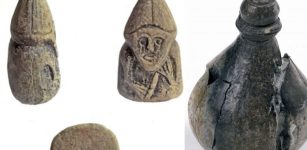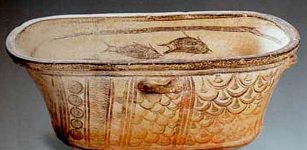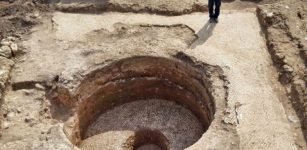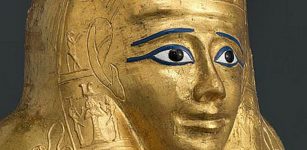Imago Mundi: Famous Babylonian World Map Is The Earliest Known In The World
A. Sutherland - AncientPages.com - This cuneiform ancient map of the Babylonian world is an archaeological treasure equal to the Rosetta Stone and the code of Hammurabi. It probably originates from Sippar, southern Iraq.
The Babylonian World Map, also known as Imago Mundi is usually dated to the 6th - 7th century BC. It is one of the oldest known world maps (if not the oldest) and certainly the most famous one.
A close-up view of the Babylonian map of the World. This partially broken clay tablet contains both cuneiform inscriptions and a unique map of the Mesopotamian world. Probably from Sippar, Mesopotamia, Iraq. 700-500 BCE. The British Museum, London.
According to the Babylonian view, this map represents the entire world known to them.
The tablet contains both a cuneiform inscription and a unique map of the Mesopotamian world at the time of Sargon (2300 BC) as a circle surrounded by water, with Babylon at its center.
The inscription indicates that it was a copy of a previous map and the locations featured on the map indicate that the original could not have been created earlier than the 9th century BC. The majority of the Babylonian Map of the World is preserved.
The earth is depicted with two concentric circles, one inside the other. The inner circle, the earth, contains eight small circles, most of which are labeled, which represent cities.
Babylon is shown in the center (the rectangle in the top half of the circle), and Assyria, Elam and other places are also named. The central area is ringed by a circular waterway labeled 'Salt-Sea'.
The outer rim of the sea is surrounded by what were probably originally eight regions, each indicated by a triangle, labeled 'Region' or 'Island', and marked with the distance in between.
The Babylonian Map of the World with translations. © Trustees of the British Museum. (After Reade, 2008). Image via Avary Taylor, Marian Feldman/Rice University
The cuneiform text describes these regions, and it seems that strange and mythical beasts, as well as great heroes, lived there, although the text is far from complete.
The regions are shown as triangles since that was how it was visualized that they first would look when approached by water.
On the map, “Assyria” (perhaps the Assyrian city Nineveh), “Der,” and “Susa,” the Elamite capital, are labeled. Two other circles are simply labeled “city” (Akkadian URU) and three circles show a central dot but are unlabeled. These unlabeled circles are perhaps representations of the “ruined cities” (ālānu abtūtu) mentioned in the text on the obverse. Babylon, rather than being represented as a circle, is rectangular with an encased dot.
Three geographic areas are labeled but not enclosed within a shape:
1) Urartu, a kingdom located in the plateau between Anatolia, Mesopotamia, Iran, and the Caucasus Mountains;
2) Habban, a Kassite tribal area in western Iran; and
3) Bit Yakin, the territory of an Aramaean tribal group located on the southern Euphrates. Topographical features include the unlabeled Euphrates River, which bisected Babylon in the first millennium BCE, a “mountain” (šadû), a “swamp” (apparu), and a “channel” (bitqu). The placement of the Euphrates, which is shown running from the “mountain” down to the “swamp,” seems to indicate that the mountain should be identified as those in southeastern Turkey, the source of the Euphrates, while the “swamp” would depict the marshlands along the southern Euphrates that existed in antiquity.
The channel, then, may be identified as an ancient waterway used to bypass the marshes and enter the Persian Gulf. The outer circle of the Map of the World is labeled “salt-sea” (Akkadian marratu). Four triangular “regions” (nagû) extend out from the ocean, although there were probably eight in total, the remaining three not being preserved on the fragmented tablet. Of the four semi-preserved nagû, only one has a description beyond lengths of distance, naming it “Great Wall, where the Sun is not seen.” ( Avary Taylor, Marian Feldman/Rice University).
The map is sometimes taken as a serious example of ancient geography, but although the places are shown in their approximately correct positions, the real purpose of the map is to explain the Babylonian view of the mythological world.
Written by – A. Sutherland - AncientPages.com Senior Staff Writer
Copyright © AncientPages.com All rights reserved. This material may not be published, broadcast, rewritten or redistributed in whole or part without the express written permission of AncientPages.com
Expand for referencesMore From Ancient Pages
-
 Mysterious Sleeping Beauty Of Loulan Mummy Is Still Perfectly Preserved After 3,800 Years!
Civilizations | Oct 30, 2014
Mysterious Sleeping Beauty Of Loulan Mummy Is Still Perfectly Preserved After 3,800 Years!
Civilizations | Oct 30, 2014 -
 Wonderful Long-Lived Nymphs In Greek And Roman Mythologies
Featured Stories | Mar 29, 2024
Wonderful Long-Lived Nymphs In Greek And Roman Mythologies
Featured Stories | Mar 29, 2024 -
 Why Was Napoleon Bonaparte Defeated At Waterloo?
Ancient History Facts | Jul 3, 2017
Why Was Napoleon Bonaparte Defeated At Waterloo?
Ancient History Facts | Jul 3, 2017 -
 Strange Ancient Mechanical Flying Animals – Mystery Of The Air Castle – Part 2
Ancient Mysteries | Mar 31, 2020
Strange Ancient Mechanical Flying Animals – Mystery Of The Air Castle – Part 2
Ancient Mysteries | Mar 31, 2020 -
 Huge Ancient Hydraulic System Built By The Liangzhu Culture May Be World’s Oldest And Predate Mesopotamian Water Systems
Ancient Technology | Dec 9, 2017
Huge Ancient Hydraulic System Built By The Liangzhu Culture May Be World’s Oldest And Predate Mesopotamian Water Systems
Ancient Technology | Dec 9, 2017 -
 Rare Find Provides New Insight Into Etruscan Life Under Rome
Archaeology | Sep 3, 2022
Rare Find Provides New Insight Into Etruscan Life Under Rome
Archaeology | Sep 3, 2022 -
 Old Norse Settlers Traded Walrus Ivory With Kyiv – Spectacular Archaeological Finds Reveal
Archaeology | Jun 16, 2022
Old Norse Settlers Traded Walrus Ivory With Kyiv – Spectacular Archaeological Finds Reveal
Archaeology | Jun 16, 2022 -
 Cleveland’s Prehistoric Sea Monster Had A Mouth Twice As Large As A Great White Shark
Fossils | Mar 3, 2023
Cleveland’s Prehistoric Sea Monster Had A Mouth Twice As Large As A Great White Shark
Fossils | Mar 3, 2023 -
 Freya – Vanadis: Beautiful Desirable Goddess And Her Brisingamen Necklace In Norse Mythology
Featured Stories | Jan 21, 2018
Freya – Vanadis: Beautiful Desirable Goddess And Her Brisingamen Necklace In Norse Mythology
Featured Stories | Jan 21, 2018 -
 Women’s March On Versailles: One Of The Most Significant Events Of The French Revolution
Ancient History Facts | Oct 11, 2018
Women’s March On Versailles: One Of The Most Significant Events Of The French Revolution
Ancient History Facts | Oct 11, 2018 -
 Was Hygiene Important For Our Ancestors?
Featured Stories | Feb 11, 2017
Was Hygiene Important For Our Ancestors?
Featured Stories | Feb 11, 2017 -
 ‘Yunatsite’ And Thought-Provoking Theory That Balkan Peninsula And Not Mesopotamia Was The Cradle Of Civilization
Featured Stories | Feb 14, 2023
‘Yunatsite’ And Thought-Provoking Theory That Balkan Peninsula And Not Mesopotamia Was The Cradle Of Civilization
Featured Stories | Feb 14, 2023 -
 Large 1,500-Year-Old Winepress Unearthed In Area Once Known For Wine production.
Archaeology | Oct 29, 2015
Large 1,500-Year-Old Winepress Unearthed In Area Once Known For Wine production.
Archaeology | Oct 29, 2015 -
 Gilded Coffin Of Nedjemankh, Priest Of Ram-God Heryshef Recovered By Egyptian Authorities
Archaeology | Mar 12, 2019
Gilded Coffin Of Nedjemankh, Priest Of Ram-God Heryshef Recovered By Egyptian Authorities
Archaeology | Mar 12, 2019 -
 4,000-Year-Old ‘Woodhenge’ Discovered In Denmark Is An Extraordinary Find!
Archaeology | Mar 10, 2025
4,000-Year-Old ‘Woodhenge’ Discovered In Denmark Is An Extraordinary Find!
Archaeology | Mar 10, 2025 -
 Enigma Of The Mysterious Ancient Shining Twins – The Cosmos Connection – Part 2
Ancient Mysteries | Jun 8, 2020
Enigma Of The Mysterious Ancient Shining Twins – The Cosmos Connection – Part 2
Ancient Mysteries | Jun 8, 2020 -
 On This Day In History: Storming Of The Paris Fortress – Prison Bastille – On July 14, 1789
News | Jul 14, 2016
On This Day In History: Storming Of The Paris Fortress – Prison Bastille – On July 14, 1789
News | Jul 14, 2016 -
 Strange Tooth Raises Unexpected Questions About Human Evolution
Archaeology | Mar 24, 2022
Strange Tooth Raises Unexpected Questions About Human Evolution
Archaeology | Mar 24, 2022 -
 Mystery Of The Cave Where People Vanish Or Become Disoriented
Featured Stories | Jan 2, 2024
Mystery Of The Cave Where People Vanish Or Become Disoriented
Featured Stories | Jan 2, 2024 -
 Very Rare Ancient Roman Horse Brooch Discovered In UK
Archaeology | Mar 7, 2020
Very Rare Ancient Roman Horse Brooch Discovered In UK
Archaeology | Mar 7, 2020


